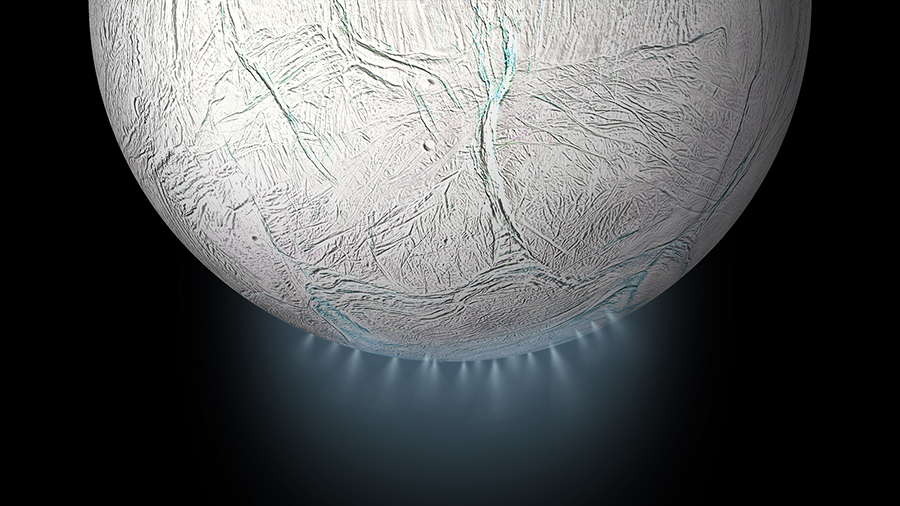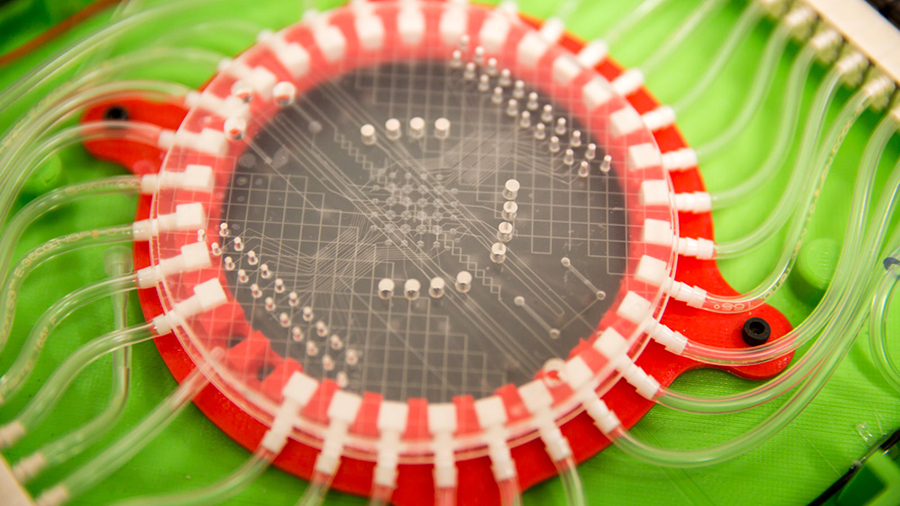Mechanical Engineering Professor Developing Sensor to Possibly Detect Life on Saturn's Ice Moon Enceladus
By: Amanda Bowman
 Courtesy NASA/JPL-Caltech
Courtesy NASA/JPL-Caltech
The moon is no longer the king of conquests in outer space. The 21st century space race is heavily focused on Mars, wanting to colonize it. Even though Earth's red neighbor offers plenty of awe and wonder, there is still a vast amount of the solar system left to be explored.
Exploring Space Beyond Mars
The Cassini explorer was launched by NASA in 1997. Along the way, it performed flybys of Venus and explored Jupiter. Cassini eventually observed seasonal changes on Saturn and one of its moons, Titan, before making its final approach on Sept. 15, 2017, slamming into Saturn and disintegrating like a fiery meteor.
One of Cassini's key discoveries during its 10 years came from observing Enceladus, another one of Saturn's 62 confirmed moons, which is encased in a thick, icy shell. It discovered Enceladus has a global ocean with indications of hydrothermal activity, i.e., heated water.
Jungkyu (Jay) Kim, an assistant professor in Texas Tech University's Department of Mechanical Engineering in the Edward E. Whitacre Jr. College of Engineering, is working with NASA to see if there is life on Enceladus by developing a microfluidic processor that will decode the chemical composition of the ice encasing the moon.
“Enceladus has a lot of plume activity, like a geyser, but ice pops out from the ground,” Kim said. “I'm developing the instrument that is really sensitive to see all the chemical composition profiles. Since it's hard to estimate what types of life activity is outside of Earth, that's why we try to see the profiles of various bio-composition and organic chemical compounds.
“For example, there are only 20 genetically encoded amino acids that are essential building blocks throughout the history of life on Earth. There are a bunch of amino acids, but we don't need them, which is why we're not making them. That's why, by checking the chemical profile outside Earth, we may see a different chemical profile that maybe some other life needs.”
Building the Sensor

The microfluidic processor integrated with a chemical sensor Kim is developing is not as big as one might imagine. In fact, it's only about four inches wide. It's composed of flight-certified silicone materials and glass.
“We can include about 100 microvalves on it,” Kim said. “We can manipulate it to where A and B mix or B and C mix, whichever microfluidic manipulation you need for chemical mixing and analysis for downstream chemical sensor.
“This chemical sensor is basically these long channels on the glass,” Kim said. “This is what we call capillary electrophoresis. It's very common in organic chemistry tools. But since the sensor holds tiny volumes of liquid, we need it. It holds less than five microliters. The sample collected will be 10 microliters, then it will mix, labeling target organic compounds for chemical analysis. It's fully automated.”
Since the microfluidic processor is essentially like a central processing unit found in a computer, Kim will be able to modify the program to do different jobs based on the need from Earth.
“Depending on the program, it can do multiple tasks,” Kim said. “So, when unexpected failure happens, we can tweak the program by sending a signal from Earth, and it will reset the program. That's a really neat process for doing this work.”
The sensor is just a small part of the actual device that is going to be sent to Enceladus, and Texas Tech isn't the only university involved in the project. Teams from the University of California at Berkeley and Georgia Tech University are working on different portions, such as the structure that houses Kim's microfluidic processor.
The Journey to Enceladus

Depending on how the planets are aligned, it could take a spacecraft anywhere from 41 days to 289 days to get to Mars from Earth. Sending a probe to Enceladus from Earth is going to take 4 to 7 years. However, the long process doesn't faze Kim much.
“Seven years isn't so bad,” he said. “I'll still be alive.”
The long journey and treacherous climate make it even more imperative for the teams to construct a sturdy contraption.
“Another challenge is capturing the ice because the flyby is about 50 km per second,” Kim said. “That is hypervelocity. So when the ice particles hit the materials, we have to make sure it's not going to puncture it or else everything evaporates and there's nothing left to analyze. All teams in this Enceladus project are trying to find organic survival rate by mimicking the hypervelocity situation, so we're testing a capture chamber now.”
Other Possibilities
Though the major purpose for Kim's microfluidic processor is to go to Enceladus, there are many more uses for it. He also uses it for testing purposes in other areas.
“Over in my lab, one of the areas we're focusing on is we're trying to mimic organs,” said Kim, who also is an adjunct professor in the School of Medicine at the Texas Tech University Health Sciences Center. “One focus is on the cornea in the eye. In order to test eye medicine, some companies use rabbits because they blink very slowly. That's really bad ethically. So, we try to build cornea structures in the chip so we can use that chip for testing any eye drug developed instead of animals. We also can use it to mimic the eye environment of contact lens users, because there's always a chance for bacteria to grow and penetrate the cornea layer if contact lens become contaminated. We can test for that. Another focus is the heart valve. We try to mimic the pumping profile inside the chip so we can see how the cell responds to a specific pumping profile.
“The third category is bimodal detection sensor. It's a paper-based fluidic device, like a pregnancy test kit. It's easy to tweak. So, we developed that and a portable device to analyze blood.”
Kim's processor is going to be used by NASA to help try to detect life, but he hopes it will also help save lives by using lab-on-a-chip technology funded by the National Science Foundation.
“When using the lab-on-a-chip to analyze blood, we're focusing on a cardiac panel to help detect a heart attack,” Kim said. “Right before people have a heart attack, certain biomarkers increase significantly. If people in distress can monitor the level of cardiac biomarkers frequently, it might save their lives.”
Discoveries
-
Address
Texas Tech University, 2500 Broadway, Box 41075 Lubbock, TX 79409 -
Phone
806.742.3905 -
Email
vpr.communications@ttu.edu
